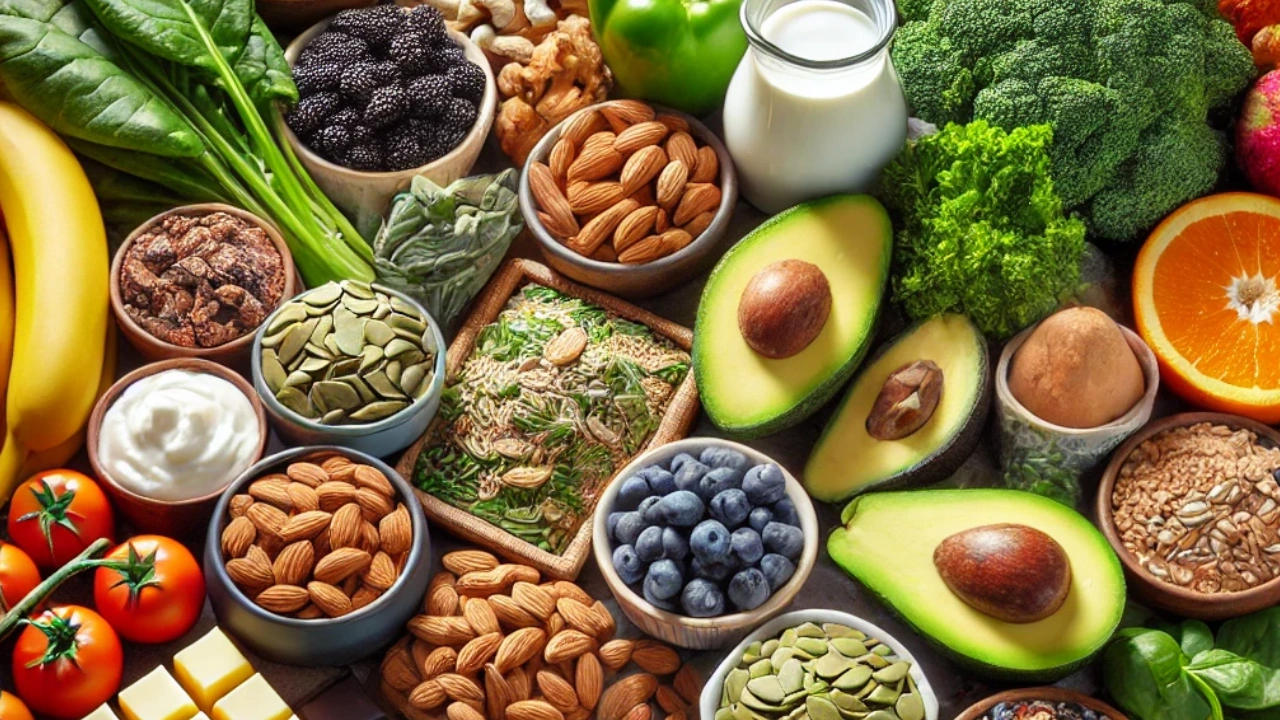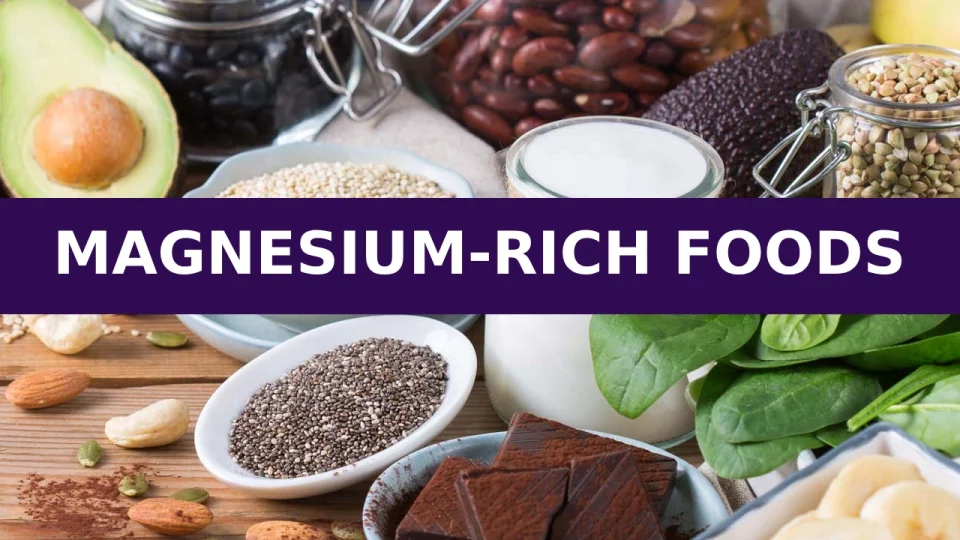Magnesium is an essential mineral that plays a vital role in many bodily functions, including muscle and nerve function, blood sugar regulation, and protein synthesis.
Despite its importance, many people do not get enough magnesium in their diets, which can lead to a variety of health issues such as muscle cramps, fatigue, and even cardiovascular problems. Fortunately, there are plenty of magnesium-rich foods that can help you meet your daily requirements.
Table of Contents
⚕️ The Importance of Magnesium
Before diving into the list of magnesium-rich foods, it’s essential to understand why magnesium is so crucial for your health. Magnesium is involved in over 300 biochemical reactions in the body, making it one of the most important minerals for overall well-being. Here are some key functions of magnesium:
- Muscle Function: Magnesium helps regulate muscle contractions and relaxations, preventing cramps and spasms.
- Nervous System Support: It plays a role in neurotransmitter release and nerve function, aiding in mental clarity and reducing stress.
- Bone Health: Magnesium works alongside calcium and vitamin D to maintain strong bones and prevent osteoporosis.
- Heart Health: Magnesium helps regulate heart rhythm and supports healthy blood pressure levels.
- Blood Sugar Regulation: It helps regulate insulin levels, which can prevent or manage type 2 diabetes.
Given the many roles magnesium plays, it’s clear that ensuring adequate intake is crucial for maintaining good health. Let’s take a look at some of the best dietary sources of this essential mineral.
🌟 Top Magnesium-Rich Foods
Leafy Green Vegetables
Leafy greens like spinach, kale, and Swiss chard are among the best sources of magnesium. One cup of cooked spinach, for example, contains about 157 mg of magnesium, which is roughly 40% of the recommended daily intake for women and 37% for men.
- Why You Should Eat Them: Leafy greens are also rich in other essential nutrients like iron, calcium, and vitamins A and C. Incorporating them into your diet can boost overall nutrient intake and support various bodily functions.
- How to Enjoy Them: Add spinach to your morning smoothie, make a kale salad, or sauté Swiss chard with garlic for a simple and nutritious side dish.
Nuts and Seeds
Nuts and seeds, particularly almonds, cashews, and pumpkin seeds, are excellent sources of magnesium. Just one ounce (28 grams) of almonds provides 80 mg of magnesium, while the same serving of pumpkin seeds offers a whopping 150 mg.
- Why You Should Eat Them: In addition to magnesium, nuts and seeds are high in healthy fats, protein, and fiber, making them a perfect snack for sustained energy and overall health.
- How to Enjoy Them: Enjoy a handful of nuts as a snack, sprinkle seeds over your salad, or blend them into homemade nut butter.
Whole Grains
Whole grains like brown rice, quinoa, oats, and barley are not only rich in magnesium but also packed with other essential nutrients like fiber, B vitamins, and iron. A cup of cooked quinoa contains approximately 118 mg of magnesium, while a cup of oatmeal offers about 63 mg.
- Why You Should Eat Them: Whole grains are a great source of complex carbohydrates that provide sustained energy and support digestive health.
- How to Enjoy Them: Start your day with a hearty bowl of oatmeal, use quinoa as a base for salads, or swap refined grains for brown rice in your meals.

Legumes
Legumes such as black beans, lentils, chickpeas, and kidney beans are not only rich in magnesium but also provide a substantial amount of plant-based protein, making them an excellent choice for vegetarians and vegans. A cup of cooked black beans offers about 120 mg of magnesium.
- Why You Should Eat Them: In addition to magnesium, legumes are high in fiber, which supports digestive health and helps regulate blood sugar levels.
- How to Enjoy Them: Add beans to your soups, stews, and salads, or make a delicious homemade hummus using chickpeas.
Fatty Fish
Fatty fish like salmon, mackerel, and halibut are known for their omega-3 fatty acids, but they are also a good source of magnesium. A 3.5-ounce (100-gram) serving of mackerel contains about 97 mg of magnesium.
- Why You Should Eat Them: Fatty fish support heart health, reduce inflammation, and provide high-quality protein, making them a great addition to any diet.
- How to Enjoy Them: Grill or bake salmon for a tasty main dish, or add canned mackerel to your salads and sandwiches.
Avocados
Avocados are not only a trendy food but also a magnesium powerhouse. One medium avocado provides around 58 mg of magnesium, along with healthy fats, fiber, and a variety of vitamins and minerals.
- Why You Should Eat Them: Avocados are incredibly versatile and can be incorporated into many meals. They also support heart health and are rich in antioxidants.
- How to Enjoy Them: Spread avocado on toast, add it to your salads, or blend it into smoothies for a creamy texture.
Dark Chocolate
Good news for chocolate lovers: dark chocolate is a surprisingly good source of magnesium. One ounce of dark chocolate (70-85% cocoa) contains about 64 mg of magnesium. Plus, it’s rich in antioxidants and has been shown to improve heart health and brain function.
- Why You Should Eat It: Dark chocolate provides a guilt-free way to satisfy your sweet tooth while also boosting your magnesium intake.
- How to Enjoy It: Enjoy a square of dark chocolate as a dessert, or add cocoa powder to your smoothies and baked goods.
Bananas
Bananas are often recognized for their high potassium content, but they also offer a decent amount of magnesium. A medium-sized banana contains about 32 mg of magnesium. Additionally, bananas are rich in fiber and vitamin C.
- Why You Should Eat Them: Bananas are an easy and convenient snack that provides quick energy, making them ideal for pre- or post-workout fuel.
- How to Enjoy Them: Eat bananas on their own, slice them over your cereal, or blend them into smoothies.
Tofu
Tofu, a popular plant-based protein source, is also rich in magnesium. A 3.5-ounce (100-gram) serving of tofu provides around 53 mg of magnesium. This versatile ingredient can be used in a variety of dishes, from stir-fries to salads.
- Why You Should Eat It: Tofu is a great option for those following a vegetarian or vegan diet, as it provides both protein and magnesium.
- How to Enjoy It: Add tofu to your favorite stir-fry, grill it for a tasty protein option, or blend it into smoothies for added creaminess.

Yogurt
Yogurt, particularly Greek yogurt, is a good source of magnesium, along with calcium, protein, and probiotics. A cup of plain, low-fat yogurt contains about 47 mg of magnesium.
- Why You Should Eat It: Yogurt supports gut health due to its probiotic content and provides a creamy, satisfying texture that can be enjoyed in a variety of ways.
- How to Enjoy It: Have yogurt for breakfast with granola and fresh fruit, use it as a base for smoothies, or enjoy it as a snack with a drizzle of honey.
| Food | Magnesium (mg) | Calories | Protein (g) | Fiber (g) |
|---|---|---|---|---|
| Spinach (1 cup, cooked) | 157 | 41 | 5.4 | 4.3 |
| Kale (1 cup, cooked) | 29 | 36 | 2.5 | 2.6 |
| Swiss Chard (1 cup, cooked) | 150 | 35 | 3.2 | 3.7 |
| Almonds (1 oz) | 80 | 164 | 6.0 | 3.5 |
| Cashews (1 oz) | 82 | 157 | 5.0 | 1.0 |
| Pumpkin Seeds (1 oz) | 150 | 151 | 7.0 | 1.7 |
| Quinoa (1 cup, cooked) | 118 | 222 | 8.1 | 5.2 |
| Oats (1 cup, cooked) | 63 | 154 | 6.0 | 4.0 |
| Black Beans (1 cup, cooked) | 120 | 227 | 15.2 | 15.0 |
| Lentils (1 cup, cooked) | 71 | 230 | 17.9 | 15.6 |
| Salmon (3.5 oz, cooked) | 26 | 206 | 22.0 | 0.0 |
| Mackerel (3.5 oz, cooked) | 97 | 205 | 19.0 | 0.0 |
| Avocado (1 medium) | 58 | 234 | 3.0 | 10.0 |
| Dark Chocolate (1 oz, 70-85% cocoa) | 64 | 170 | 2.2 | 3.1 |
| Banana (1 medium) | 32 | 105 | 1.3 | 3.1 |
| Tofu (3.5 oz) | 53 | 76 | 8.0 | 0.9 |
| Yogurt (1 cup, low-fat) | 47 | 154 | 13.0 | 0.0 |
▶ How to Incorporate More Magnesium-Rich Foods into Your Diet
Now that you know which foods are rich in magnesium, the next step is to incorporate them into your diet. Here are some tips to help you boost your magnesium intake:
- Plan Balanced Meals: Ensure each meal includes a source of magnesium, whether it’s leafy greens, whole grains, or nuts. Aim for a variety of magnesium-rich foods to meet your daily needs.
- Snack Wisely: Instead of reaching for processed snacks, opt for nuts, seeds, or yogurt, which provide magnesium and other essential nutrients.
- Include Magnesium in Every Meal: Incorporate magnesium-rich foods into all your meals. For example, add avocado to your breakfast, include leafy greens in your lunch, and serve salmon or tofu for dinner.
- Experiment with New Recipes: Try new recipes that feature magnesium-rich ingredients. For instance, make a quinoa salad with leafy greens, nuts, and a lemon-tahini dressing, or enjoy a smoothie with spinach, banana, and almond butter.
- Stay Consistent: Consistency is key when it comes to meeting your nutritional needs. Aim to include magnesium-rich foods in your diet regularly rather than just occasionally.
